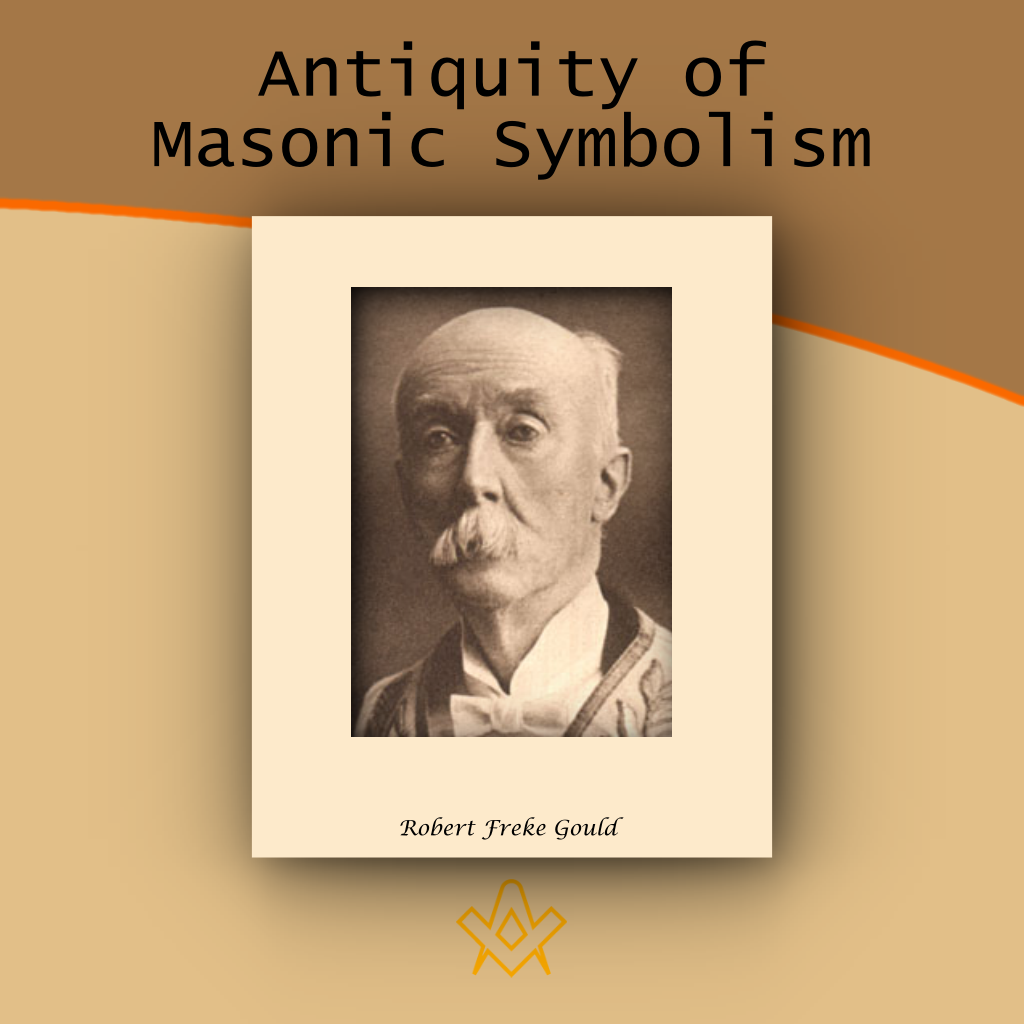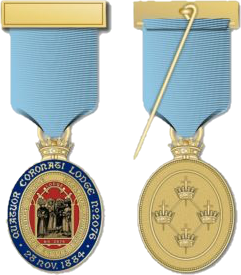Is the Symbolism of Masonry an inheritance derived from the old Masons who flourished before the era of the Grand Lodges; or has it been borrowed from the Rosicrucians or others, after 1717?
To take the wider and more comprehensive view in the first instance:—
“It is, that the Symbolism of Masonry, or at all events a material part of it, is of very great antiquity — and that in substance, the system of Masonry we now possess — including the three degrees of the Craft — has come down to us, in all its essentials from times not only remote to our own, but also to those of the founders of the earliest of Grand Lodges.”
The Secretary [Quatuor Coronati Lodge] having called upon me to read the paper which has long stood in my name — “On the Degrees of Pure and Ancient Freemasonry” — [AQC Volume 16, 1903 P28]
I find that in order to make myself generally understood, it will be desirable that I should lay before you in the first instance, what I may venture to term a preliminary thesis, which will therefore be proceeded with. But in the lecture of this evening my object is two-fold.
I wish to lay a sure foundation for a future inquiry into the early Ritual and Ceremonial, which prevailed under the Grand Lodge of England; and there is a stronger motive still for the method of treatment I have thought it advisable to adopt.
The inaugural addresses of the two brethren who have successively followed me in the chair of this Lodge, [QC lodge] seem to me to reflect pretty accurately the opinions of a portion of our members from whom much is expected in the near future.
These are, that the domain of Ancient, as distinguished from that of Modern Masonry, has been very strangely neglected, and that if we really wish to enlist the sympathy and interest of scholars and men of intelligence, in the special labours of the Lodge, we must make at least a resolute attempt to partially lift the veil, by which the earlier history of our Art or Science is obscured.
It is almost unnecessary to mention, to the brethren I am now addressing, that the adjectives “Ancient” and “Modern” as here applied to Masonry, are used in their ordinary acceptation — that is, by members of our own Lodge; or to be precise, that by the expression “Ancient Masonry,” is to be understood the history of the Craft before, and by that of “Modern Masonry,” the history of the Craft after, the era of Grand Lodges. The line of demarcation between them being therefore drawn at the year 1717.
[Editor Note: for 1717 also read 1721 or 1723 for the formation of Grand Lodge of London and Westminster]
Above that line, and reaching back to the fourteenth century, are to be found our written traditions, and whether our Symbolical traditions are entitled to take rank by their side, I shall discuss generally, and whether any place above the line can be assigned to them at all, I shall discuss specially, in the body of my paper.
By this I mean, that while putting before you some speculations with regard to the remote past of our Society, which are not inconsistent with the shreds of evidence that have come down to us, these are subsidiary to my main design, which is, to satisfy your minds, that beyond all reasonable doubt the essentials of:
the Three Craft Degrees must have existed before the formation of the first Grand Lodge — that of England — in 1717.
More than this, I shall not seek to establish, though I hope at the close of my lecture, the inclination of your judgment may be in the direction of my own, which is that the balance of probability is in favour of as early an origin being attributed to our symbolical as to our written traditions.
But if there should prove to be, at the close of the discussion which will follow this paper, anything at all approaching a consensus of opinion that the ceremonial of Masonry pre-dates the era of Grand Lodges, a highly important object will have been attained.
Scholars and antiquaries take but a languid interest — there is no use in disguising it — in the history of Modern Masonry. They do not believe that the system of Masonry, as understood by the founders of the first Grand Lodge, is capable of indefinite expansion.
Degrees, in their judgment, cannot be multiplied ad infinitum. But the history and origin of Ancient Masonry are regarded by them in quite a different manner.
These, they are not only willing but eager to study and investigate, yet an unwelcome doubt obtrudes itself which checks, if it does not wholly dissipate, the ardour of their research.
Conjointly with the old MS. Constitutions, which are of undoubted antiquity, the symbolical teaching in our Lodges — though possessing a remoteness of origin less assured — has a peculiar fascination for all genuine votaries of archaeology.
Here, however, the doubt referred to, creeps in, and the scholar or antiquary who has a longing to trace the antiquity of our symbolism, is checked by similar reflections to those which occurred to Gibbon, who kept back an hypothesis he had framed with regard to the real secret of the Ancient Mysteries, “from an apprehension of discovering what never existed”; and to the elder Disraeli, who much in the same way, excused his imperfect speculations with regard to the shadowy and half-mythical Rosicrucians.
But if the symbolism of Masonry, or a material part of it, can be proved with reasonable certainty to ante-date the year 1717, the doubt, upon which I have enlarged, will disappear, and with it we may venture to hope, the present disinclination on the part of really competent investigators, to extend their researches into the only field of inquiry — the domain of Ancient Masonry — which offers any prospect whatever of rewarding the patient student of our antiquities, by a partial revelation of the origin, and by the recovery of some portion at least of the lost learning of the fraternity.
Before, however, proceeding with my main argument, let me introduce a few historical data, which if kindly kept in mind, will give a better grasp of the very complicated subject I have to deal with in this paper.
It is well known, that the first Grand Lodge, that of England, was founded by four London Lodges in 1717; also, that by students of the Craft, it is customary to speak of the Masonry which existed before that date as Ancient, and of the Masonry which followed afterwards as Modern.
[Editor Note: the Apple Tree Lodge, one of the four is in dispute that it did exist in 1716/17, also some now consider the first Grand Lodge of England to have formed in 1721, or as now 1723]

John Montagu, 2nd Duke of Montagu, by Sir Godfrey Kneller, Bt (died 1723), given to the National Portrait Gallery, London in 1945.
IMAGE LINKED: wikimedia Attribution 4.0 International (CC BY 4.0)
The Grand Lodge of England pursued the even tenor of its way, without much variety occurring, until the year 1721, which is the next date I shall ask you to carry in your recollection.
In this year two important things happened. First of all, a great nobleman, the Duke of Montagu, was elected Grand Master, and the Society rose at a single bound into notice and esteem. Secondly, Mr. James Anderson, a graduate of Marischal College, Aberdeen, and who was then a Presbyterian Minister in London, was selected by the Grand Master and the Grand Lodge as the most competent person to adjust, as it were, the Masonry of Ancient times upon a Modern basis.
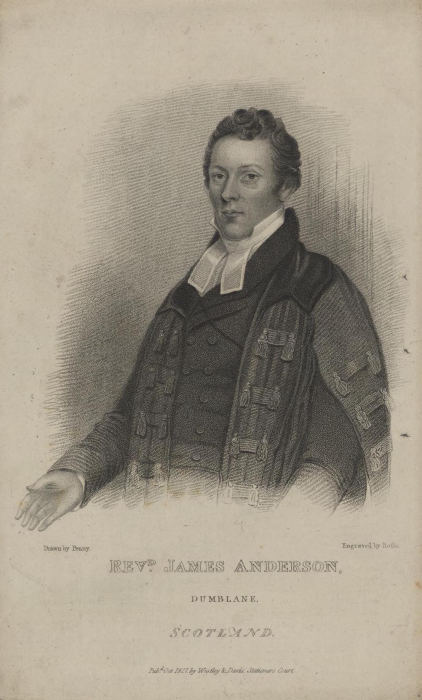
Rev. James Anderson – engraving by John Roffe, Evangelical Magazine, 1827, published by Westley & Davis, Stationers Court.
IMAGE LINKED: wikimedia Attribution 4.0 International (CC BY 4.0)
The following is an extract from the minutes of Grand Lodge, 29th September, 1721: —
“His Grace’s Worship and the Lodge finding fault with all the copies of the Old Gothic Constitutions, order’d Brother James Anderson, A.M., to digest the same in a new and better method.”
The Constitutions referred to were certain old documents, usually in roll or scroll form, containing the Legend of the Craft and a Code of Ancient Regulations, both of which it was the custom in old days to read over to the operative Masons on their first admission into the Lodge.
By the aid of these MS. Constitutions, Anderson compiled the first “Book of Constitutions,” which was published in 1723. This work contained a quantity of “Regulations,” No. XIII, of which runs as follows:— “Apprentices must be admitted Masters and Fellow Craft only here [i.e., in the Grand Lodge] unless by a dispensation.”
This usage, however, was again varied by the Grand Lodge, on November 25th, 1725, when it was ordained, “That the Master of Each Lodge, with the consent of his Wardens and the Majority of the Brethren, being Masters, may make Masters at their discretion.” [1]
From the foregoing it will appear that only two degrees (or distinct ceremonies) were recognised by the Grand Lodge of England in 1723, Apprentice, and Fellow Craft or Master, the two latter being convertible terms; also, that in 1725, the restriction was removed and that “Masters” could be made by private Lodges at discretion.
The period embraced by some of the figures I have given you, viz. from 1717 to 1723, [2] has been styled the Epoch of Transition, because in the opinion of many leading authorities, the system of Masonry we now possess (or in other words, the three degrees of pure and Ancient Masonry, as we are accustomed to call them), was then manufactured or concocted.
Against this view, however, we find arrayed, the conviction of another set of authorities, who are firm believers in Masonic degrees, and discredit the notion that any alterations were made by the Grand Lodge of England, in the secrets of Masonry — except in what may be termed non-essentials, or to speak with more precision, in the method adopted of imparting them.
Thus, there are two theories or schools of thought with regard to the degrees, or to use an expression I prefer, the Symbolism of Masonry, a wider term, and one which will cover everything done or practised in the Lodges at a later period than the so-called Epoch of Transition (1717-23), and for which (it is alleged on one side) no equivalent is to be found in the doings and practices of the Lodges in existence prior to 1717.
Each of these views or theories has its supporters, and to whichever side the argument may for the moment seem to preponderate, we cannot be too careful to recollect — that there is evidence to the contrary.
The number of authorities, indeed, by which either of these two beliefs is upheld, is so evenly balanced, that there is no middle course between reading the testimony on one side, and despising the other so thoroughly, as to refrain from ever looking at it, or to do as I shall propose to you in the present instance, that is, to give each side a patient hearing.
To-night, indeed, I can only put before you one branch of the case, namely the arguments which I think may be adduced in favour of the antiquity of degrees, or to use the wider expression already adopted, of Masonic Symbolism.
But they will go far I trust, towards covering the whole ground, and if not, in the general reply to which I shall be entitled at the close of the discussion, I will do my best to grapple fairly with any counter-arguments which may be advanced in support of the other side of the question.
By this method of treatment, I shall be able to present you — not so much with my personal conclusions, as that with what will serve as an ultimate basis for your own.
There is an old saying, Quot homines, tot sententiae, “as many men, so many opinions” — and if for “men” you read “lecturers,” it stands to reason, that while every person who reads a paper before you, might give a different opinion if you invited an expression of his individual judgment or crotchets upon the question in dispute — on the other hand you would be always sure to evoke some useful information, calculated to assist you in arriving at an independent conclusion, if you were to ask what could be said both on the one side and on the other.
Of the important part played by the Rev. James Anderson in the moulding of Ancient Masonry, 1721-23, upon what are averred to have been “new lines,” I shall have more to say, when I get to the body of the lecture, but I ask you to carefully note the fact, that when, in 1721, it was designed to consolidate the “Constitutions of Ancient and Modern Masonry,” the task of doing so was confided to a Scotsman, and who as there is good ground for believing, had been received into the Society while a resident in Aberdeen.
It may now be convenient to formulate in words, the precise question which will constitute my main contention this evening. It is this:—
Is the Symbolism of Masonry an inheritance derived from the old Masons who flourished before the era of the Grand Lodges; or has it been borrowed from the Rosicrucians or others, after 1717?
There is also a secondary contention (or series of speculations) to which I have already referred, viz., that the Symbolism of Masonry, is very old indeed — much older than the seventeenth century, but I freely admit having been led to this supposition by a chain of conjectural evidence, which facts alone can substantiate.
For convenience sake, however, and in order to illustrate more clearly the line of argument I shall pursue, let me also formulate in words the bye or side issue, which I am desirous of raising for your consideration:—
Is there ground for supposing that the Symbolism of our present Freemasonry, existed in mediaeval times, and that it has decayed pari passu [on equal footing], with the operative Masonry of that period, and come down to us, divested of much of its real significancy, as a legacy or inheritance from the working Masons of those early times?
In the next place, and before I proceed to state my case, let me, in order that you may better understand it, when duly laid before you — make use of a comparison.
Unlike that of other nations, the civilization of Egypt presents a continuous deterioration from the earliest ages to the latest.
The further we go back the more consummate is the art, the more complete the command of mechanical processes and appliances.
In other words the civilization of Egypt must have culminated before the very earliest dawn of its recorded history.
If Egypt is not altogether exceptional and abnormal, the use of the mechanical methods employed by the Pyramid builders points to an antecedent civilization of which the extent in time becomes literally incalculable, while it seems to become more and more inexplicable the more its real character is investigated and brought to light.
In the same way, I conceive that there is ground for reasonable conjecture, whether the Symbolism of Masonry, to a considerable portion of which, even at this day, no meaning can be assigned which is entirely satisfactory to an intelligent mind — must not “have culminated before the very earliest dawn of its recorded history.”
Also, that it underwent a gradual process of decay, which was arrested but only at the point we now have it, by passing into the control of the Grand Lodge of England in 1717.
Against this view, it may of course be contended, and — as many will think — with, perhaps, equal plausibility, that instead of a decline, there was an advance, a progressive development of Masonic Symbolism, and that with the solitary exception of a rude form of initiation or reception, we have inherited nothing external to the operative practice of our ancestors, the working Masons.
But as the old proverb says, “If you run after two hares you will catch neither.” In maintaining the affirmative of the proposition, that the Symbolism of Masonry, has come down to us with a very respectable flavour of antiquity, I cannot undertake at one and the same time, both the attack and defence.
At this stage, and before proceeding any further with my remarks, it may be convenient if I re-state the two propositions of which I shall maintain the affirmative.
To take the wider and more comprehensive one in the first instance:— “It is, that the Symbolism of Masonry, or at all events a material part of it, is of very great antiquity — and that in substance, the system of Masonry we now possess — including the three degrees of the Craft — has come down to us, in all its essentials from times not only remote to our own, but also to those of the founders of the earliest of Grand Lodges.”
The foregoing embraces the general contention which will pervade this address, and I shall therefore hope to be excused for once more bringing it under your notice, though I ask your more particular attention to the narrower proposition of the two, viz., that the Symbolism of Masonry is older than the year 1717.
This is my special contention which I shall endeavour to press home, and should our united labours result in the determination of what has hitherto been a moot point with Masonic scholars, a very distinct advance will have been made, in the path of inquiry, which it is the object and mission of the Lodge to follow up.
In dealing with the complicated problem, which I have undertaken to treat in this lecture, I feel that I shall have need of your indulgence, while I attempt to place before you in a clear and connected form, the scattered shreds of evidence wherein we may see, as in a glass dimly, a pale reflection of some of the historic past of Freemasonry.
But on the other hand, I am no less convinced that the lecturer who is unable to make the abstruse moderately simple, is not gifted with a very clear intellect, or is lacking in that modicum of literary ability which the members of a Lodge like our own, have at least the right to expect in any one of their number, who takes upon himself the function of attempting either to instruct or entertain them.
Hence if I fail to put my points before you, with all the clearness that might be desirable, the fault will be my own, nor shall I register an apology in advance — for as the Duke well says to the Weaver, in A Midsummer Night’s Dream, “Never excuse, if your play be a bad one, keep at least the excuses to yourself.”
[TO ILLUSTRATE THE LECTURE]
12th Century
Masons’ Tool-Marks in Europe betray a Western Origin: Transition from the Norman to the Gothic or Pointed Style of Architecture, and possible introduction of Symbolic or speculative teaching among the stone-masons of Britain practising that style.
13th Century
Progressive development of the Gothic or Pointed Style, and of its accompanying symbolism. The Masons’ tool-marks betray an Eastern Origin.
ENGLAND: The Masons’ tool-marks betray an Eastern Origin.
SCOTLAND: The old style of tooling continued.
14th Century
ENGLAND: Continued Progressive development.
SCOTLAND: War of Independence; building stayed: decay of Mediaeval Operative Masonry when only partially developed.
15th Century
ENGLAND: Wars of the Roses; dormancy of the Craft Lodges in both its Operative and Speculative features; partial reproduction of the Gothic style.
SCOTLAND: Lodges exist for trade purposes only, though fragments of an incomplete symbolic (or speculative) system are handed down in an imperfect manner: Ceremonial very simple.
16th Century
ENGLAND: The Reformation; no more churches built; the builders die out.
SCOTLAND: As before.
17th Century
ENGLAND: Lodges survive, mainly for Speculative purposes; Elias Ashmole initiated, A.D. 1646; “Manner of adoption very formall;” and probably adumbrated by that of the Lodge of Aberdeen, A.D. 1670.
SCOTLAND: As before.
18th Century
ENGLAND: “Signs and Tokens” of the Freemasons alluded to in print, 1709; Formation of the Grand Lodge of England, 1717; Dr Anderson ordered to “digest” the old MS. Constitutions, 1721; printed book of Constitutions, 1723.
SCOTLAND: Lodge procedure characterized by great simplicity until after 1717; English system of three degrees gradually introduced; Grand Lodge of Scotland erected, 1736.
The task immediately before me, is to make a beginning in historical Masonry. Let us therefore, in the first instance, put entirely on one side the speculations of Modern writers, and ascertain what independent authorities there were, before the era of Grand Lodges, by whom any period of origin has been assigned to our British Freemasonry.
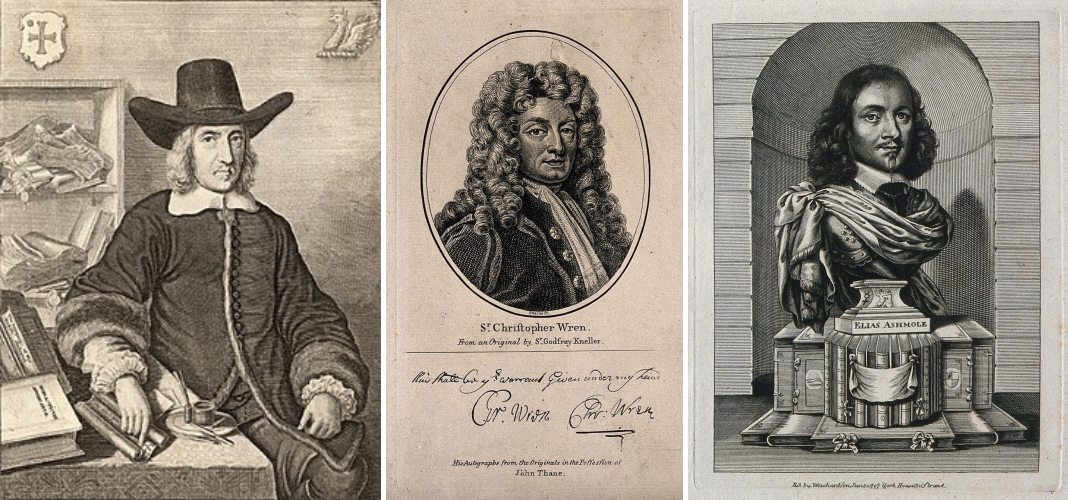
left: Sir William Dugdale of Blyth Hall, 1656, etching by Wenceslaus Hollar.
centre: Sir Christopher Wren. Line engraving after Sir G. Kneller, 1711.
right: lias Ashmole. Line engraving, 1747, after W. Faithorne.
IMAGE LINKED: wikimedia Attribution 4.0 International (CC BY 4.0)
Three such authorities maybe cited, Sir William Dugdale, Sir Christopher Wren, and Elias Ashmole, whose several opinions have already been recorded in our Transactions, [3]
One of these, however, the statement ascribed to Dugdale, probably the greatest antiquary of his age, must again be referred to. John Aubrey, in his Natural History of Wiltshire, written (though not published) in 1686, observes:—
“Sr William Dugdale told me many years since, that about Henry the third’s time the Pope gave a Bull or diploma to a Company of Italian Architects to travel up and downe over all Europe to build Churches. From these are derived the Fraternity of Free-Masons. They are known to one another by certayn Signes & Watch words: it continues to this day. They have Severall Lodges in severall Counties for their reception: and when any of them fall into decay, the brotherhood is to relieve him, &c. The manner of their adoption is very formall [please note this], and with an Oath of Secrecy.”
Very much to the same effect are the opinions of Sir Christopher Wren and Elias Ashmole. Upon the strength of these great names, it was customary for a very long period to fix the establishment of the Freemasons in England about the early part of the reign of Henry III, at which period, it was averred, that Gothic Architecture — which first of all began in the East — came forward into practice as a regular established order, and the inference was suggested (as being irresistible) that the invention and introduction of this bold and very highly scientific order of architecture must be referred to these chosen and selected artists. [4]
Just fifty years ago, however, Sir Francis Palgrave observed:—
“The number of writers, at home and abroad, who have discussed the origin of Gothic architecture, and each of whom drives his own theory round his own park, is probably now not much less than a hundred. Yet, as far as we can judge, no one of these enquirers ever persuaded another to adopt his own opinion.” [5]
During the half century which has elapsed since the foregoing statement first saw the light, a great host of additional writers have fastened upon the same theme, and a few words expressed thereon by myself, in 1883, may not, perhaps, be deemed out of place.
“Gothic is not only the last link in the chain of genuine and original style, the architecture of the modern as distinguished from that of the ancient world, but it was also the product of a peculiar romantic temperament developed at that particular period, which was totally unlike anything that has been seen either before or since, even among the same nations, and which showed itself, not only in architecture, but literature, and even in politics, notably in the great movement of the Crusades.” [6]
“It is good sheltering under an old hedge,” but I have a stronger reason for placing before you, as a basis for our inquiry, the alleged connection of the Freemasons with Gothic architecture, than the mere contention that a theory grows venerable by its age.
In the autumn of 1888, the British Archaeological Association held its annual session in Glasgow, and among the papers read before it was one by our present Junior Warden, (Professor T. Hayter Lewis), which bore the following title:— “Scottish Masons’ Marks compared with those of other countries.”

Among the conclusions formulated by this excellent authority, all of which he satisfactorily establishes by comparing the Masons’ Marks in our own and foreign countries, are:
• That certain definite methods of marking the general surfaces of the stones, characterised the masonry of the styles which we call Norman, and that this had apparently a Western origin.
• That in the thirteenth century there was introduced, with the Early Pointed Style (which is another name for Gothic], an entirely different method of finishing the surface, and that the source of this method was apparently from the East.
• That Masons’ Marks do not appear to have been commonly used in Europe until late in the twelfth century.
• That some of the most prominent of these marks appear to have been used continuously, from very early times, in Eastern countries.
Our Bro. J. W. then draws attention to the opinion of Viollet le Duc, that the clergy who were in the company of the Crusaders returned to Europe with the knowledge of what had been done by the Saracens, and endeavoured to apply what they had seen — the art of the Saracens [Islamic architecture] having thus a great influence on that of the West.
He next observes:—
“I know that it will be said that the evolution of the Pointed [or Gothic] style was that of gradual development.
So, no doubt, to a large extent, it was, as must be the case with every invention, no matter what.
But I absolutely refuse to believe that so great a change, made in so short a time, was the result of a mere system of gradual improvement; nor can I believe in the theory which would assign the change to a partnership of minds, be they monks or citizens, in monasteries or guilds.
In every great movement which the world has seen, some one great mind comes forth as a pioneer; nor can I think that it has been otherwise with our art.”
Our Bro. J.W. winds up with the following:—
“I am not enthusiastic enough to suppose that the marks which the workmen have left will ever be so outspoken as to tell us of the man; but I do believe that the search into their meaning — a search which was not even begun until some fifty years since — may lead us to the place and to the means by which its influence was so powerfully and quickly spread.”

Mason’s mark from Nidaros Cathedral, Trondheim, Norway, late 12th century.
IMAGE LINKED: wikimedia Attribution 4.0 International (CC BY 4.0)
It is not too much to say, that Masons’ Marks, which have hitherto been regarded by our advanced students, as presenting a sentimental value out of all proportion to their serviceable worth, are now, owing to the research of Professor Hayter Lewis, shewn to be a very important factor in the complicated problem of Masonic history.
According to Sir William Dugdale, or to put it in another way, according to the popular belief or the oral tradition prevailing in his time, the Freemasons derived their origin from a company of architects empowered “to travell up and downe over all Europe to build churches” — “about Henry the Third’s time,” i.e., the thirteenth century, while, at the same period, if we follow the Junior Warden, there was introduced with the Early Pointed (or Gothic) Style, “an entirely different method of finishing the surface, and that the source of this method was apparently from the East.”
“It is good to have two strings to one’s bow,” or as otherwise expressed —
“Good riding at two anchors, men have told,
If one fail, the other may hold.”
Those who disregard the opinions ascribed to Sir William Dugdale, Sir Christopher Wren, and Elias Ashmole, viewing them as mere assertions, and wholly devoid of proof, will however, look very differently on the careful and close reasoning of Professor T. Hayter Lewis.
Indeed, as it seems to me, the arguments of the Junior Warden, virtually re-instate the old tradition, that is, in its material features, viz., the connection of the Freemasons with Gothic architecture, and the derivation in some measure of that art or style from the East.
In his learned work — “Europe in the Middle Ages” — Hallam tells us:—
“Some have ascribed the principal ecclesiastical structures to the fraternity of Freemasons, depositaries of a concealed and traditionary science.
There is probably some ground for this opinion; and the earlier archives of that mysterious association, if they existed, might illustrate the progress of Gothic architecture and perhaps reveal its origin.” [7]
The passage last quoted is a typical one, and in the idea it embodies has of late years been regarded as reaching the high water mark of credulity.
But, as we have seen, the essay or paper read by Professor Hayter Lewis, says, in effect, almost, if not quite the same thing, the only difference being, that in recommending a search for the origin and progress of Gothic architecture, the Professor is the more practical guide of the two, as instead of looking for archives which do not exist, he prudently counsels a careful examination of the marks or emblems wrought by the Medieval Masons — which are to be met with at this day.
It will be in the recollection of my hearers, that the Junior Warden advances a very daring hypothesis. He says:—
“In every great movement which the world has seen, some one great mind comes forth as its pioneer; nor can I think that it has been otherwise with our art.”
He does not believe in the theory which would assign the change from the Norman to the Early Pointed (or Gothic) Style, to a partnership of minds, be they monks or citizens, in monasteries or guilds.
Thus, instead of a School, he boldly suggests that it is a Man, to whom we must look as the pioneer of the great architectural movement which set in during the 13th century.
“The stream can never rise above the spring-head,” so, if such a master-mind there was, the genealogy of the Freemasons, so far at least as it synchronizes with the rise of Gothic architecture, is exhausted.
But let us see whether the idea thrown out by Bro. Hayter Lewis, can be utilized in the particular inquiry we are pursuing.

Wells Cathedral – the first English cathedral to be designed in the Early Gothic style.
IMAGE LINKED: wikimedia Attribution 4.0 International (CC BY 4.0)
If the Early Pointed Style of Architecture (one of the phases of Gothic) was due to the genius and commanding personality of an individual, it may be fairly assumed, that like the youngest son of King Athelstan, as recorded in the Masonic document [8] standing next in point of antiquity to the Regius MS.,
“Of speculatyfe he was a master,”
or, in other words that he was amply skilled in the knowledge, as well as in the practice, of the science of geometry, and a proficient, so to speak, both in speculative and in operative Masonry. [9]

Ripon Cathedral East End – an example of Middle or ‘Decorated’ Gothic. By Gary Ullah from UK – Ripon cathedral,
IMAGE LINKED: wikimedia Attribution 4.0 International (CC BY 4.0)
After the Early Pointed, came another phase of Gothic, [10] the Middle or Perfect Pointed Style, known in England by the name of Decorated.
It lasted from the end of the 13th to the end of the 14th century, and during this period immense progress had been made in the technique of the art. Stone had become, so to speak, as ductile as wax in the hands of the builders, who had surmounted every difficulty of construction. After the Decorated Style, the finest age of Gothic architecture is at an end.
Still, though English architects appear, after the close of the 14th century, to lose something in wealth of spontaneous invention, the feeling for beauty of ornamental work was not yet to decay till at least the royal chapels of Windsor, Westminster, and Cambridge, and other fascinating fan-roofed buildings, were finished, — with which the true Gothic Architecture of England went out “in a blaze of glory” under the Tudors.
Yet, although with the construction of the Churches and Cathedrals of the 13th and 14th centuries, the vitality of Gothic as a pure style of construction came to an end, many futile attempts to reproduce the style were made, and the practice was continued down to the death of Queen Elizabeth I (1602).
But by this time the great object for which Gothic had been invented — the suitable celebration of a gorgeous religious ceremonial, by which an unlettered nation might be instructed, impressed, and governed — had ceased to exist, and after the Reformation, as soon as other means for the instruction of the people were provided, the Gothic cathedral was employed for other purposes, the Gothic style of architecture all but died out, and its constructive principles and processes, and even its traditions, — as I shall hereafter more particularly suggest to you — were forgotten.
Thus the decline of Mediaeval Architecture was due to natural causes, like the fall of monasticism and all things mediaeval, and the one followed suit on the other.
No more churches were built, and hence the builders died out; and with them, to a great extent, I believe, died the skill in arch and vault building, which was, perhaps, the great characteristic of the builders of the Middle Ages.
Gothic, however, never quite died out, and I shall now suggest to you, that the same thing may be predicated with regard to the Symbolism of the Craft — if it existed at all, within the period covered by the rise and fall of Mediaeval Operative Masonry?
Reasoning by analogy, there is evidence from which a belief that it did exist, will spring up in many minds.
“In the oldest of the Chinese Classics — the Book of History — which embraces a period reaching from the twenty-fourth to the seventh century before Christ, we meet with distinct allusions to the Symbolism of the Masons’ art. But even if we begin,” says Mr. Giles, “where the ‘Book of History’ ends, we find curious masonic expressions to have been in use — at any rate in the written language — more than seven hundred years before the Christian era; that is to say, only about a couple of hundred years after the death of King Solomon himself.”
Also, in a famous canonical work, called THE GREAT LEARNING, which is referred to the fifth century before our era, we read, that a man should abstain from doing unto others what he would not they should do unto him; “and this,” adds the writer, “is called the principle of acting on the square.”
Mr. Giles also quotes from Confucius, B.C. 481, and from his great follower, Mencius, who flourished nearly two hundred years later. In the writings of the last-named philosopher, it is taught that men should apply the square and compasses figuratively to their lives, and the level and the marking line besides, if they would walk in the straight and even paths of wisdom, and keep themselves within the bounds of honour and virtue.
In Book VI. of his philosophy we find these words:—
“A Master Mason, in teaching his apprentices, makes use of the compasses and the square. Ye who are engaged in the pursuit of wisdom must also make use of the compasses and square.” [11]

By Prospero Intorcetta, Philippe Couplet, et al. – Confucius Sinarum Philosophus, Public Domain
IMAGE LINKED: wikimedia Attribution 4.0 International (CC BY 4.0)
Bro. Chaloner Alabaster tells us:—
“Going then to the records we possess of the earliest historic times in China, I find clear evidence of the existence of a mystic faith expressed in allegoric form, and illustrated, as with us, by symbols.
The secrets of this faith were orally transmitted, the chiefs alone pretending to have full knowledge of them. I find, moreover, that in these earliest ages this faith took a Masonic form, the secrets being recorded in symbol buildings like to the Tabernacle Moses put up in the desert, and the Temple his successor Solomon built in Jerusalem; that the various offices in the hierarchy of this religion were distinguished by the symbolic jewels held by them during their term of office, and that, as with us, at the rites of their religion they wore leather aprons, such as have come down to us, marked with the insignia of their rank.” [12]
According to the same authority, the mysteries of this ancient faith have now become lost, or at best obscured, though attempts at a revival may be traced in the proceedings of existing brotherhoods, whose various rituals and signs are supposed to be in some measure founded on ancient rites and symbols which have been handed down from the earliest ages. [13]
The preceding extracts I shall use no farther than to assume, on the strength of them, that among a very ancient people, and prior to the Christian era, there was a moralization of the implements of the Masons’ trade, together with a symbolical teaching which in course of time became lost or obscured.
Indeed, the first learning of the world, consisted chiefly of symbols. “The wisdom of all the Ancients that is come to our hands,” says Dr. Stukeley, “is symbolic.” Also, as it is well put by Dr. Barlow, “emblems, symbols, types, all have this in common : they are the representatives of something else for which they stand.” [14]
The last definition is that upon which I shall rely, in advancing the hypothesis that with emblems, symbols, or types, the stonemasons of the 14th century were familiar.
“During the splendour of Mediaeval Operative Masonry,” observes Bro. Albert Pike, “the art of building stood above all other arts, and made all others subservient to it. It commanded the services of the most brilliant intellects, and of the greatest artists.”
Very much to the same effect, though somewhat differently expressed, are the remarks of Professor Rogers, who states:—
“I have never studied the history of the Craft, but there can be no reason to believe that any very important principles of so mechanical an art as architecture were incommunicable except to these mystics, if indeed the brethren for whom so remote an antiquity and so wide spread an association, is claimed by their whimsical representatives in modern times, had any virtual existence.
I am disposed to believe that just as when one sense is extinguished in any person the rest are stimulated to preternatural acuteness, so in the ages with which we are concerned, when literature was so scanty, and the means of occupation so unvaried, the single art which was developed in any notable degree was studied with such intensity and concentration as to bring about results which we, in our wider modes of thought, study and application, find it difficult, if not impossible, to rival.” [15]
It is well known that the symbolical method of instruction which had been in use from the earliest times in Egypt, was adopted by the Jews.
Hence under the cloak of symbols, Pagan philosophy gradually crept into the Jewish schools, and the Platonic doctrines, mixed first with Pythagorean, and afterwards with the Egyptian and Oriental, were blended with their ancient faith in their explanations of the law and the traditions.
The society of the Therapeutae was formed after the model of the Pythagorean system; Aristobulus, Philo, and others, studied the Grecian philosophy, and the Cabbalists formed their mystic system upon the foundation of the tenets taught in the Alexandrian schools.

Philo of Alexandria – By André Thévet – André Thevet (1502-1509): Les vrais pourtraits et vies des hommes illustres grecz, latins et payens (1584), Public Domain
IMAGE LINKED: wikimedia Attribution 4.0 International (CC BY 4.0)
From various causes, between the third century and the tenth, but few traces of the Cabbalistic mysteries are to be met with in the writings of the Jews, but their peculiar learning began to revive when the Saracens became the patrons of philosophy, and their schools subsequently migrated to Spain, where they attained the highest distinction.
These in the 13th and 14th centuries became the resort of Christian artisans, to instruct themselves in the useful arts. The Universities of Toledo, Cordova, Seville, and Granada, were sought by the pale student from other lands, to acquaint himself with the sciences of the Arabs, and the treasured lore of antiquity.
There can, indeed, be little or any doubt, that with the termination of Mediaeval operative Masonry, many of the most abstruse and abstract principles of the building art were wholly lost. For this a reason has been suggested — which may possibly be true — that these principles were presented in symbolic form.
But however this may be, it is at least certain that in the 13th and 14th centuries, the unlimited resources of architectural skill were everywhere applied to develop divine ideas through symbolized stone. The single object which presented itself to the Masonic architect was to find suitable expressions for the heart yearnings and moral aspirations of the people. [16]
Nor was symbolization unknown to the actual workmen or stone-masons.
Our early operative brethren, though somewhat coarse, were in their way, extremely witty.
Stone caricatures are still to be met with, equal in strength and coarseness to those of Rowlandson and Gillray, nor need we be astonished to find a good deal turn upon the clergy, as do a great number of those of our English draughtsmen, especially in the matter of tithe; and these, together with indecencies which are, after all, not quite unknown in more refined ages, were probably the amusements of grimly-humorous workmen, when they thought they could indulge in them without fear of discovery.
Thus in old churches and cathedrals we find portrayed, a nun in the embraces of a monk, a Pope descending to hell at the last judgment, a fox in priest’s robes preaching to a congregation of geese, an ass performing high mass, etc.
That the class of workmen last referred to, possessed some knowledge of architectural symbolism, or to use more familiar words, that they symbolised the implements of their trade, has been assumed by many writers, a conclusion to which I am also led, and although incapable of strict proof, may, as it seems to me, be fortified to some slight extent by analogy.
We have already seen that during the splendour of Mediaeval Operative Masonry, the art of building, stood at the head of all the other arts, but there is a remarkable circumstance connected with the Masons’ trade, to which I shall next advert, in further illustration of its unquestionable supremacy.
By no other craft in Great Britain has documentary evidence been furnished of its having claimed at any time a legendary or traditional history.
Our written traditions are carried back — speaking roundly — to the 14th century, and to me at least, it does not appear one whit more extraordinary, that our symbolical traditions may have enjoyed an existence in a period of time equally remote.
This leads us to the next branch of my general subject, the written traditions of the Freemasons, in the earliest of which, as we shall presently see, there is much to confirm the idea I have already thrown out, that symbolical Masonry was coeval with the most ancient writings of the Craft that have come down to us.
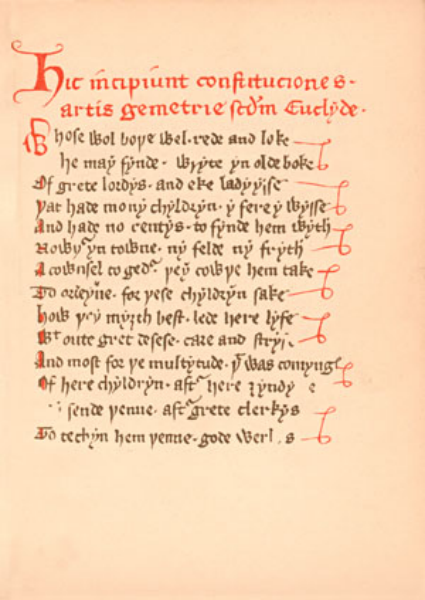
the Regius MS. or Masonic poem,
IMAGE LINKED: wikimedia Attribution 4.0 International (CC BY 4.0)
To pass, however, to our written traditions, — there are in the first instance, two histories of, or disquisitions upon, Masonry or Geometry, dating — according to the British Museum Authorities — from about — 1425, and afterwards a long series of documents dating from about 150 years later, to which the name of Manuscript Constitutions has been applied.
Of the two histories or disquisitions, one is in metrical and the other in prose [17] form, and it is with the former, the Regius MS. or Masonic poem, (in the present inquiry) that we are alone concerned.
This manuscript, evidently belonged to a guild or fraternity of Masons, as it gives the legendary history of their Craft, and furnishes regulations for their conduct.
But it is chiefly remarkable on account of the last hundred lines being almost exactly the same as a non-Masonic-poem, called Urbanitatis, giving minute directions for behaviour — in the presence of a lord — at table — and among ladies — all of which being clearly intended for gentlemen of those days, it has been argued, would have been out of place in a code of manners drawn up for the use of a Guild or Craft of artisans, and hence that the MS. must have been possessed by a Guild or fraternity, which commemorated the science, but without practising the art of masonry, that is, that they were what we should now call, speculative or Symbolical Masons. [18]
* Note: The Urbanitatis noted above may be read at the end of this present transcription – g.l.h.
It is stated, in the introduction to the Masonic Poem, that the craft of geometry was founded in Egypt by Euclid, and given the name of Masonry; and in reference thereto, Bro. Albert Pike [19] says:—
“Many of the symbols of the old religions, of Pythagoras, and of the Hermetics of later days, were geometrical figures ∴ Some of these were symbolic because they represented certain numbers, even among the Assyrians and Babylonians.
To the knowledge of these symbols, perhaps, the name ‘geometry’ was given, to avert suspicions and danger.
The architects of churches revelled in symbolism of the most recondite kind.
The Pyramids are wonders of Geometrical science. Geometry was the handmaid of Symbolism. Symbolism, it may be said, is speculative Geometry.”
In the preceding views all indeed, may not concur, but the point should not escape us, that in the oldest writing of our Craft — for such the Regius MS. undoubtedly is — we meet with inculcations which are very far removed from the mental range of the operative brethren to whom the Manuscript Constitutions were rehearsed at a later era.
This will accord with the supposition that Masonry as a speculative science, declined or fell into decay, pari passu, with Masonry as an operative art.
Leaving these two histories of, or disquisitions upon Masonry, which date as before stated, at about the year 1425, let me next take you to the Manuscript Constitutions, of which the oldest dated form is the “Grand Lodge” MS. of the year 1583.
Between these two periods there is a gap of 158 years, and with regard to it there are some considerations for which a further quotation will assist in preparing us.
The Rev. W. Denton, in his England in the 15th Century, tells us:—
What was true of morals and material wealth, was true also of art. Architecture had yielded to the spirit of the age; it had lost much of its nobleness, though it had not yet descended to the depths it afterwards reached. The hand of the English sculptor had grown stiff, and the forms from his chisel no longer vied in grace with the productions of the Italian artist.
Henry III came to the Throne at the close of the long and savage War of the Roses.
During the continuance of the struggle the nation went back in many ways from the refinement of the 14th century.
The cultivation even of house fruits ceased with the rain of houses and manors and the desolation of orchards and gardens.
The population dwindled. The arts lost their vigour and beauty.
The architecture, sculpture and metal work were not equal to what they had been, and fresh life was needed when peace was once more secured.
In the beginning of the reign of Henry VIII, we have the complaint of Sir Thomas Elyot, which would have sounded strange in the ears of a contemporary of Edward I., that “in painting and carving, in graving and embroidery, Englishmen be inferior to all other people.” [20]
In Scotland, the deterioration of the arts was even greater.
The victory of Bannockburn drove from Scotland the very elements of its growing civilization and its material wealth. The artisans of North Britain were at that time mostly English.
These retired, or were driven from Scotland, and with them the commercial importance of the Scottish towns was lost.
The estates held by Englishmen in Scotland were confiscated, and the wealth which, through the hands of these proprietors had found its way from the southern parts of the kingdom and fertilized the more barren soil of the north, at once ceased.
No cathedral was built after the reign of David I in 1153, and almost every monastery was founded before the death of Alexander III in 1286. All these marks of refined taste and religious zeal, of wealth and public spirit ceased with the rebellion of Bruce. [21]
Coronation of King Alexander on Moot Hill, Scone. He is being greeted by the ollamh rígh Alban, the royal poet of Scotland, who is addressing him with the proclamation “Benach De Re Albanne” (= Beannachd Dé Rígh Albanaich – “God Bless the King of Scots”)
IMAGE LINKED: wikimedia Attribution 4.0 International (CC BY 4.0)
It will be seen therefore, that while England went back many degrees in civilization during the Wars of the Roses, an even greater relapse into comparative anarchy took place in Scotland owing to the War of Independence.
These historical gleanings will aid our comprehension of the extreme simplicity of the Scottish Masonic ritual, as generally known to have existed, in the 17th century.
In what was then the leading Magazine of the Craft, Bro. W. P. Buchan — at that time one of the foremost investigators of Scottish Masonic history — thus expressed himself in 1869:—
“Seeing how difficult it is even now, with all the aids to help and oft-recurring meetings, to get office-bearers and brethren to work our ceremonies properly, how did the old Lodges get on before 1717, who only met once a year? Oh, how elaborate must the ceremony have been, when one Mason could make another? Or, where could brethren learn our present system, had such been in use before 1717?” [22]
To indulge in a further quotation from the same writer:—
“Those who indulge in dreams about the mysterious sciences (!) taught in pre-eighteenth century Masons’ Lodges, only retail the groundless fancies of a heated imagination, while those who assert that the Masons occupied a higher position in the public estimation than any of the other Crafts are mistaken.
The old Weavers used to carry a pretty high head, and Edward III of England joined the ‘Linen Armourers,’ and if it were properly looked into, in a truthful manner, we would find that the operative Masons some centuries ago were no greater geniuses than they are at present.
In fact, [and here I ask your special attention], the question is open to investigation whether the progress of the art of building, say in Britain, e.g., has it or has it not kept pace with the progress of the other arts?” [23]
I have quoted from Bro. Buchan, for whom as a Masonic student I have a great respect, for a double purpose. First of all because he puts into vigorous and incisive language a theory or belief, which is in direct opposition to the hypothesis I am presenting to you this evening ; and secondly, because from the point of view I am now arguing, I think it can be shown that both facts on which he bases his own inference, viz., the decay of the building art, and the simplicity of the Lodge ceremonial before 1717, may equally well represent cause and effect, and if so, not only do not militate against, but are in exact harmony with, the line of argument I am submitting for your consideration.
Let me now return to the Manuscript Constitutions, whose place in Masonic history I shall next attempt to define.
You may have noticed just now, that while alluding to the early Scottish Masonic ceremonial, I said nothing about its English equivalent.
Of this indeed, we know little or nothing, for the Manuscript Constitutions, which, in a certain sense, may be described as “tombs without an epitaph,” convey very scanty information with regard to living Freemasonry in the South.
We know indeed, that they were used, i.e., read over to candidates of the operative class, at their reception into the Lodge, but as to the formulary observed at the admission of gentlemen we are ignorant. [24]
Lodge minutes there are none, that is, of earlier date than the 18th century, and here a word of caution must be thrown out, against the too prevalent habit of confounding the systems of Masonry prevailing in Scotland and England respectively, the one with the other.
It is of course both easy and natural to do so. Each system presents some evidence in which the other is lacking, but we shall find I think in both cases, that like streams of water flowing in divergent courses from a common source, they have grown more impure the farther they have run from the fountain-head.
In both countries, during the 17th century, there was speculative as well as operative membership in these Lodges. Yet a difference is found which should be noted.
In Scotland, the Lodges existed for trade purposes, but in England not exclusively so, indeed, quite the reverse, if we limit our observation to the only 17th century Lodges, of which any particulars have come down to us.
From this it will at least be a plausible conjecture — I shall put it no higher for the present — that while in the one instance — Scotland — the ancient symbolism of Masonry had descended to the level of the ordinary artisan; in the other instance — England — more of the old framework still existed.
Much light would be shed on this point if there were English minutes to refer to, but as the English Lodges were not kept together for trade purposes — like the Scotch — they must have some other raison d’être for their continuance, which if it were not a fuller ceremonial, and more ornate ritual, than was usual in the North — lands us in a still greater puzzle than that which we are attempting to solve.
I have already stated on the authority of Sir William Dugdale, what in the 17th century appears to have been the popular belief with regard to the Freemasons, and let us not forget, that:—
“common fame,
is seldom to blame”
The Freemasons, we are told by Dugdale, “are known to one another by certayn signes & watch-words∴ The manner of their adoption is very formall.”
That there was a plurality of signs, we also find stated by Dr. Plot, in 1686, [25] and a plurality of “words and signes” is attested by a manuscript dating from about 1665. [26]
In 1709, that is to say, eight years prior to the establishment of the earliest of Grand Lodges, Mr. (afterwards Sir Richard) Steele, wrote, in a journal called the Tatler, about a certain class of people, of whom he says:—
“They have their signs and tokens like Free-Masons.”
In 1717, as previously explained, the Grand Lodge of England was founded by four London Lodges, and as for about two hundred years all the London Companies have, with insignificant exceptions, ceased to be connected in any real way with the trades whose names they bear, I must not exclude any evidence from which it has or may be contended, that the Society, remodelled in 1717, was a Company of Freemasons, that at some previous time had relinquished the occupation which gave them a name.
Such evidence will be found in Harl. MS., 1942, and the Antiquity MS. These are copies or versions of the MS. Constitutions, and in the former which as a written document dates from about the beginning of the 17th century, the following occurs among the charges and inculcations:—
4thly. “You shall secure and keepe secret the obscure and intricate parts of the science, not disclosing them to any but such as study & use the same.”
The same MS. uses the expression “accepted free Mason,” who is required to provide himself with a certificate from the Lodge that “accepted him,” and there is a clause which I quote at length:—
“That for the future the sayd Society, Companies, & fraternity of Freemasons shall bee regulated, & governed by one Master, & Assembly, & Wardens, as ye said Company shall think fit to chose, at every yearely generall Assembly.”
The “Antiquity” MS., the other copy of the MS. Constitutions, has the following attestation clause:—
“Written by Robert Padgett, Clearke to the Worshippfull Society of the Free Masons of the City of London in the second yeare of the Raigne of our most Gracious Soveraign Lord King James the Second of England, &c. Annoq Domini, 1686.”
Here, then, we have two pieces of evidence, one telling us that in the beginning of the 17th century, the government of the Society, Company, and fraternity of Free Masons, was confided to one Master, Assembly, and Wardens.
And the other, that towards the close of the same century, viz., in 1686, there was a copy of the MS. Constitutions, written by the clerk of “the Worshippfull Society of the Free Masons of the City of London,” which it is possible may have been the identical Society, Company, or fraternity of Free Masons, founded, or as it were, welded together, about 60 or 70 years previously.
These documents, however, leave much to be desired. They come down to us very insufficiently attested, and are uncorroborated by evidence from any other quarter, which would be admissible in a court of law.
The silence, therefore, of all the other versions of the Manuscript Constitutions with regard to points of such importance, and as one might naturally suppose, of such notoriety, has led most students to regard them as among those puzzles that are occasionally met with in Masonic history, which in the absence of further evidence are insoluble. [27]
Still, “all feet tread not in one shoe,” and I must not omit to state, in fairness to a minority of students, who may be satisfied as to the authenticity of these documents — that in the City Companies there have always been three grades of members. The first was that of freeman or freewoman ; the second, membership of the livery; and the third a seat in the Court. Here, some may think we have the framework of our three degrees of Speculative or Symbolical Masonry.
The foundation of the Grand Lodge of England was a great event, and has been styled “the Revival, of A.D. 1717,” which indeed it may have been, though not in the sense generally employed, viz., as the resuscitation of a pre-existing Grand Lodge. The late Bro. Woodford said with much force:—
“Where did the Freemasonry of 1717 come from?
To accept for one moment the suggestion that so complex and curious a system, embracing so many archaic remains, and such skilfully adjusted ceremonies, so much connected matter, accompanied by so many striking symbols, could have been the creation of a pious fraud or ingenious conviviality, presses heavily on our powers of belief, and even passes over the normal credulity of our species.
The traces of antiquity are too many to be overlooked or ignored.” [28]
Nor is it indeed, in my own judgment, entertainable for an instant, that the old London Masons of 1717 would have looked calmly on, had the forms and ceremonies to which they were accustomed been as suddenly metamorphosed, as it has become, to some considerable extent the fashion to believe.
Neither can we credit that at the close of Ancient, and the beginning of Modern, Masonry, there was an instantaneous change of actors — the old party retiring and the new one coming in. One generation of men, as Hume remarks, does not go off the stage at once, and another succeed, as is the case with silkworms and butterflies. [29]
The continuity of the Society, which was maintained by a constant succession of new members, may be compared to that of a woven cloth, the stitches of which interlace, so that its texture is not divisible into intervals or stages.
It was thus very different from the continuity of any one Lodge, which perhaps may be likened to that of a chain formed of single links.
Four Lodges, at least, took part in the so-called “Revival” of 1717, and both the Grand Master (Sayer), and the Grand Senior Warden (Lamball), then elected, remained active members of the Grand Lodge, until long after the “Epoch of Transition.”
But I must proceed by steps. The Society of Freemasons established on a new basis in 1717, made very slow progress in public favour. Dr. Stukely, the celebrated antiquary, tells us in his diary, under the date of January 6th, 1721 — on which day he was initiated —
“I was the first person made a Freemason in London for many years. We had great difficulty to find members enough to perform the ceremony. Immediately upon that it took a run, and ran itself out of breath thro’ the folly of the members.”

William Stukeley. Mezzotint by J. Smith, 1721, after Sir G. Kneller, 1721..
IMAGE CREDIT: wellcome collection Attribution 4.0 International (CC BY 4.0)
The “run” referred to by Dr. Stukely, took place, no doubt, owing to the prestige acquired by the Society in the same year, through the acceptance by the Duke of Montagu of the Grand Mastership, and it was also in the same year, 1721, that Mr. James Anderson, a Scottish Presbyterian Minister was selected by the Grand Master and Grand Lodge to revise the old, or Manuscript Constitutions of the fraternity — which saw the light in 1723.
Mr., or as he afterwards became, Dr. Anderson, was, as you already know, a graduate of Marischal College, Aberdeen, and I shall now submit to you the extreme probability that he was also a graduate of the Masonic Lodge in that city.
The three degrees of pure and ancient Masonry, viz., those of Master Mason, Fellow Craft, [30] and Entered Apprentice, bear titles which were evidently borrowed from the vocabulary of Scotland.
Master Mason, it is true, was a term common in both kingdoms, but viewed in conjunction with the others, the three expressions may be regarded as having been taken en bloc, from the operative terminology of the northern kingdom.
All these expressions will be found in the Schaw Statutes — 1598 — the records of Mary’s Chapel, Edinburgh — 1601 — and the Laws of the Aberdeen Lodge — 1670 — (Scottish documents).
But the same terms — Master Mason, Fellow Craft, and Entered Apprentice, as grades of symbolical Masonry, are not alluded to in any book or manuscript of earlier date than 1723.
Indeed, with the exception of the first-named — Master Mason — the expressions themselves do not occur — at least I have never met with them in the course of my reading — in the records of the building trades, or in the printed or manuscript literature of England preceding the publication of Dr. Anderson’s “Book of Constitutions,” produced according to the mandate received by him from the Grand Lodge of England, in 1723.

Anderson’s Constitutions 1723
IMAGE LINKED: wikimedia Attribution 4.0 International (CC BY 4.0)
The question then is, whence did the doctor derive them? which renders it essential that we should take a closer view of the system of Masonry, under which there can be little or any doubt, that he himself had acquired his knowledge of the Craft.
The oldest register of the Aberdeen Lodge is dated 1670, and contains the names of 49 members, who are described as “the Authoires of and Subscryuers of this Book.”
The Master was “Harrie Elphinstone,” collector of the King’s Customs.
Four noblemen were among the members, and of the whole 49, eight only are estimated to have been operative Masons. From this circumstance it is usually supposed, and I think rightly, that the large speculative membership of the Lodge must date back many years at least.
The 11th signature in the register is that of the Scribe, described as “James Anderson, Glassier and Measson, and wreatter of this book,”
And curiously enough, his namesake, Dr. James Anderson, the Presbyterian Minister, not only imitates the form in which the signatures are shown on the Aberdeen roll, when he gives the names of the representatives of the English Lodges who signed the 1st Book of Constitutions in 1723, but also fills in his own as
James Anderson, A. M. (Master.)
The Author of this Book.
This strengthens the presumption of Dr. Anderson’s connection with the Lodge, as well as with the University of Aberdeen, and there is further evidence from which the same may be inferred, though space forbids my doing more than indicate where it may be found. [31]
Among the “Lawes and Statutes” ordained by the Lodge of Aberdeen, on the 27th December, 1670, are the following:—
“Wee ordaine that no Lodge be holden within a dwelling house where there is people living in it, but in the open fields except it be ill weather, and then let a house be chosen that no person shall heir or sie us. (3rd stat.)
“Wee ordaine lykwayes that all entering prentieses be entered in our antient outfield Lodge, in the mearnes in the parish of Negg, at the stonnies at the poynt of the Ness.” (5th stat.)
Now it is very remarkable that we have here, in these “Lawes” of the Aberdeen Lodge of 1670, the only evidence which throws any light whatever on the actual ritual of the Ancient Masons — by which I mean the catechism or formulary, in use at the reception of a new member, prior to the formation of the Grand Lodge of England in 1717.
There is absolutely no evidence at all from English sources, and only the above quoted laws from any Scottish one.
It was the practice, as we have seen, of the Aberdeen Masons, to hold their Lodge and enter their apprentices in the open air. Next let me read you some extracts from publications which appeared after Dr. Anderson had printed his book of Constitutions in 1723.
The 1st is from the “Mason’s Examination,” also published in 1723. It runs:—
Q. Where was you made?
A. In the valley of Jehosophet, behind a Rush-bush, where a Dog was never heard to bark, or Cock crow, or elsewhere.
The 2nd is from “The Grand Mystery of the Freemasons Discover’d,” printed in 1724:—
Q. How many make a Lodge?
A. God and the Square, with Five or Seven right and perfect Masons, on the highest Mountains, or the lowest Valleys in the World.
The 3rd is from “Masonry dissected,” 1730.
Q. Where does the Lodge stand?
A. Upon Holy Ground, or the highest Hill, or lowest Vale, or in the Vale of Jehosaphat, or any other Secret Place.
Now if we look closely into these catechisms, — that of 1723, mentions the “Valley of Jehosophet,” but not the highest hills and lowest valleys.”
The next one, of 1724, does just the opposite, — the “Valley of Jehosophat” is not named, but “the highest Mountains, and lowest Valleys” are; while in the catechism of 1730 we find both phrases in full — from which we may, I think, conclude, that by incorporating what was given in the two others, it really goes back beyond or behind them, and reproduces in an ampler form, many details of a still earlier catechism than has come down to us.
These pretended revelations must be handled with due caution. In the year 1730, Deputy Grand Master Blackerby spoke in the Grand Lodge of the author of “Masonry Dissected” as “an Impostor,” and “of his Book as a foolish thing not to be regarded.”
But even a sullied stream is a blessing compared to a total drought, and in the absence of evidence upon which we can confidently rely, even waifs and strays from the most tainted sources are not to be disregarded, provided they bear at least the impress of antiquity. [32]
We may assume, however, from the publications I have cited, without endeavouring either to reconcile their discrepancies, which would be a manifest impossibility, or to look for meanings which probably never had any existence, that the practice of Lodges meeting, and of persons being made Masons, in the open air, and under conditions favourable for secrecy, was at least an article of popular belief in 1723-30, and in it we find an echo or survival of the usage so strictly enjoined by the statutes of the Lodge of Aberdeen, in 1670.
Upon this two claims may be founded, — the first, that many real customs observed in Modern Masonry (1723-30), may also rest on a similar basis of antiquity, although no actual proofs are forthcoming: and secondly, if any part whatever of the ritual of Modern Masonry was founded on the Ancient Masonry prevailing at Aberdeen in 1670, it would again be carried back — but how far I will leave you to decide for yourselves — as it is a moral certainty that the customs of a Lodge composed of forty-nine members, of whom all but eight were Speculative or Symbolical Masons, had not all grown up in a day.
Whether the Masonry of Aberdeen, and inferentially of that existing in some other parts of Scotland, was sui generis, or an importation from England, cannot be determined, but the latter supposition, if we accord due weight to the predominance of operative Masonry as a living art, in the South, seems to be the more probable of the two.
The next question for our consideration is, did Dr. Anderson remodel the ancient ritual as well as the ancient laws of the Freemasons?
The subject however is enveloped by too much confusion for a definite reply to be possible.
It is probable that he did, and that we owe to him the introduction of the Scottish operative titles, and the expansion of the system of degrees, though it is quite possible that the third degree, by which I do not mean a new ceremony, but an alteration in the method of imparting the old ones, was the work of other hands.
In Dr. Anderson’s Book of Constitutions, 1723, two grades only of Freemasons are mentioned, Entered Apprentice, and Fellow Craft or Master, the same as existed in the Lodge of Aberdeen.
But about 1725 the titles of Fellow Craft and Master became disjoined, and as Dr. Anderson was absent from the deliberations of the Grand Lodge of England, between June 1724 and June 1731, it is perhaps a fair inference that he was not concerned in the alteration.
To sum up. It is, I think, abundantly clear, that the Masonic body had its first origin in the trades-unions of Mediaeval operatives, but we must now ask ourselves, whether there was a Survival of their Symbolism, — or indeed if they possessed any at all — when Ancient Masonry put on its Modern attire, and became as it has since continued to be, a purely speculative science.
In other words, did the Freemasons of 1717, and later, retain, many forms, ceremonies, words, and symbols, which they derived from their direct ancestors, the Working Masons.
Before, however, adducing the strongest evidence I possess, in favour of the antiquity of our existing Masonic Symbolism, and which I have purposely kept back until the last moment, let me briefly state a counter-theory that has its supporters.
It is, that some men, being learned in astrology, alchemy, and cabbalistic lore generally, were also Freemasons, and took advantage of this circumstance to indoctrinate their colleagues with their own fantastic belief, and so, under the cloak, and by means of the organization of Freemasonry, to preserve tenets which might otherwise have fallen into complete oblivion.
According to Vaughan, “Mysticism has no Genealogy.
The same round of notions, occurring to minds of similar make, under similar circumstances, is common to mystics in ancient India and in modern Christendom. [33]
The same writer observes:—
“As the revival of letters spread over Europe, the taste for antiquity and natural science began to claim its share in the freedom won for theology ; the pretensions of the Cabbala, of Hermes, of NeoPlatonist Theurgy became identified with the cause of progress.” [34]

The Temple of the Rose Cross. By T. Schweighart – Speculum sophicum Rhodostauroticum (1604), Public Domain,
IMAGE LINKED: wikimedia Attribution 4.0 International (CC BY 4.0)
I shall pass lightly over a subject which has lain out of my course of study, and is, perhaps, beyond my sphere of comprehension.
But I believe it may assumed, that according to the theory of which I am trying to give yon an outline, the mystical knowledge or symbolism of the Craft, is supposed to have been introduced into the Lodges by the Hermetical philosophers, or Rosicrucian adepts, whose studies appear to have embraced the same objects, and between whom therefore the only difference seems to have been one of title, the former appellation being the earlier of the two, but the latter (owing to the alleged existence of a Society of Rosicrucians, with which, however, the other Rosicrucians must not be confounded) ultimately becoming the more common term by which those votaries of the “Chymical Art,” or “Sons of the Fire,” were alluded to.
It has been maintained by some writers, that the influence of Hermeticism upon Masonry, made itself felt during the time of Elias Ashmole, while by others it is affirmed that the symbolism of our Society is of much later institution, and that it came to us after 1717, at the hands of the Rosicrucians.
There is also a third contention — to which I have previously referred — partaking of the other two, and it is that Hermetic symbolism had penetrated into Masonry, before, “but that the working-class of Masons in the Lodges had no knowledge of it,” until after, the era of Grand Lodges.
With regard to these several theories, I shall first of all put the following case. Let us suppose that we find in an individual certain habits or idiosyncrasies, and that it is confidently asserted that he has inherited them from his grandfather.
Further, let us imagine that with regard to his intermediate ancestor, no information whatever is forthcoming, and I think it represents fairly enough, the stretch of faith that is required of us, to yield an implicit assent to the dogma of Hermetic ancestry with which we are presented.
We should, in the one case, I think, endeavour to trace the immediate paternity of the individual whose habits or idiosyncrasies were the subject of consideration, and this is precisely what I shall ask you to assist me in doing in the other case.
Under the Grand Lodge of England, within the first decade of its existence, there was a ceremonial, or, to vary the expression, certain ritual and emblematical observances were wrought in the Lodges, and whether these were then new or old, is, shortly stated, the main issue for our determination.
If I notice the fact that the Hermeticists or Rosicrucians, are not known to have practised themselves, any mystic or symbolical ceremonies which they could have passed on to the Freemasons, it is merely that I may proceed with the observation, that what is incapable of proof, is of course equally incapable of refutation.
But these alchemistical philosophers did not pursue their curious studies in one country only, and why if they fraternized with, or in any way made use of, the Masons of Britain (or their organization), they should have as resolutely refrained from doing the same thing on the Continent, is a mystery of which the explanation is withheld from us.
Much weight has been attached to the undoubted fact that Elias Ashmole was both an Hermetical philosopher, and a Freemason.
Still, conjecture must not be allowed to take the place of evidence, and we may well ask for the requisite information that will enable us to consider the influence of Hermeticism as it appears in the general body of Masonry, and not as it was circumstanced in any individual member of the Craft.
Bro. Albert Pike tells us, in words which are so beautifully chosen, that I shall need no apology for reproducing them:—
“The Symbolism of Masonry is the Soul of Masonry.
Every symbol of the Lodge is a religious teacher, the mute teacher also of morals and philosophy.
It is in its ancient symbols and in the knowledge of its true meanings, that the pre-eminence of Freemasonry over all other Orders consists.
In other respects some of them may compete with it, rival it, perhaps even excel it; but, by its symbolism, it will reign without a peer when it learns again what its symbols mean, and that each is the embodiment of some great, old, rare truth.” [35]
You will have in your immediate recollection, the words to which I specially invited your attention:— “When it learns again what its symbols mean.”
They proclaim a truth which is a cardinal feature of the theory or hypothesis that I am presenting to you this evening.
It is, that the meaning of a great part of our Masonic Symbolism has been forgotten, and here I shall proceed to show you, why in my judgment there are grounds for believing that this partial obliteration of its import must have taken place before the era of Grand Lodges.
If this view be tenable, then we may put on one side the suggestion that “the legend of the Third Degree was introduced by the new comers into Masonry, who brought into it all that is really symbolic and philosophical in the Three Degrees.” [36]
It is unlikely — not to say impossible — that any men of intellectual attainments, who joined the Craft under the Grand Lodge of England, during the first decade of its existence, would have introduced any Symbolism of which they did not understand the meaning, and I think it can be very easily shewn from the ceremonial of that period, that it must have been quite as obscure and unintelligible in many parts, in those days as it is in our own.
But as a preliminary, let us hear what a Commentator on one of the printed catechisms wrote with regard to it at the time of its publication.
Dr. Anderson himself is said to have been the writer, though I deem this to be incorrect, but the piece was written by someone possessing great ability, and was reprinted in the Book of Constitutions, 1738.
It was styled “A Defence of Masonry,” and the design of the 3rd chapter was to remove the general impression produced by the publication of Masonry Dissected, “that the principles and the whole frame of Free-Masonry was so very weak and ridiculous, that it reflected upon Men of the least Understanding to be concerned in it.”
In proof of which, it was alleged that the “Dissection” discovered “nothing but an unintelligible Heap of Stuff and Jargon, without Common Sense or Connection.”
Upon this, the learned and ingenious author of the “Defence,” who professed it to be his object to make “a few impartial Remarks upon the Dissection, without contending for the Reputation of Masonry on the one hand, or reflecting upon the Dissector on the other,” observes:—
“I confess I am of another opinion ∴ the system as taught in the regular Lodges, may have some redundancies or defects, occasioned by the indolence or ignorance of the old Members.
And, indeed, considering through what obscurity and darkness the Mystery has been delivered down; the many centuries it has Survived; the many countries, and languages, and sects, and parties it has run thro,” we are rather to wonder it ever arrived to the present Age without more Imperfections.
In short — I am apt to think that Masonry, as it is now explained, has in some circumstances declined from its original purity: it has run long in muddy streams, and as it were, underground; but notwithstanding the great rust it may have contracted, there is, (if I judge right) much of the old Fabrick still remaining: the Foundation is still intire; the essential Pillars of the Building may be seen through the Rubbish, though the Superstructure may be over run with Moss and Ivy, and the Stones by length of time disjointed.
And, therefore, as the Busto of an old Hero is of great value among the curious, though it has lost an Eye, the Nose, or the Right Hand, so Masonry with all its blemishes and misfortunes, instead of appearing ridiculous, ought (in my humble opinion) to be received with some Candour and esteem from a Veneration to its Antiquity.” [37]
The passage I have just read to you, lends no colour to the supposition that any new comer into Masonry could have remodelled the ancient ritual. Indeed, as you have seen, by the general public, “the principles, and the whole frame of Free-Masonry was deemed so weak and ridiculous, that it reflected upon men of the least understanding to be concerned in it.”
Of this a further example is afforded by some inuendoes in the “Ode to the Grand Khaibar“, [38] 1726, which besides allusions to the “unintelligible Gabble,” and “Solemn Fooleries,” of the Freemasons, has the following :—
“With empty Names of Kings and Lords
The MYSTIC LODGE may sooth the Fancy,
Words without Meaning it affords,
And Signs without significancy.”
But to pass into a higher sphere of criticism, we may infer from the “Defence of Masonry” having been reprinted with the Book of Constitutions, 1738, that in the opinion of the leading Masonic authorities, the ancient “Fabrick” (of Masonry) had sustained such ravages at the hands of time and neglect, as to raise doubts as to how much of it was “still remaining.” [39]
The proper thing to do, however, is to examine the ritual for ourselves, and here, as time presses, I must ask those brethren who are unacquainted with its peculiar phraseology to at least so far yield me their confidence, as to believe in my statement that it abounds with archaisms, which are clearly survivals of more ancient forms of speech.
I will also premise, that in choosing a title for this paper, I have been influenced by the consideration, that while the Symbolism of Ancient Masonry may have embraced many things that were absent from its Ceremonial, still all we can learn of the former must be derived from our actual knowledge of the latter — a fragment it may well be, of the symbolic teaching of more remote ages, but nevertheless, all that we can rely upon with any approach to certainty, as affording a real clue to the lost secrets of the Society.
[A verbal exposition was then given of the early ritual and ceremonial under the Grand Lodge of England, together with typical illustrations of the lost meanings of some portions of the Symbolism of Masonry.] [40]
That the Symbolism of Masonry existed before the era of Grand Lodges (1717) is, I think, a point upon which, if we reflect at all, there can be little or any variety of opinion. But if the minor contention, which has been laid before you, is established to your satisfaction, you will find, I think, that you are carried a very great way towards accepting the major one.
In other words, if the symbolism (or ceremonial) of Masonry is older than the year 1717, there is practically no limit whatever of age that can be assigned to it.
After the formation of a Grand Lodge, there was centralization. Before it there was none.
Each Lodge then met by inherent right, and even if we go so far as to admit the possibility of new and strange practices being introduced with any one of them, there was no higher body by whose authority these innovations could have been imposed on the other Lodges.
To put it in another way. If we once get beyond or behind the year 1717, i.e., into the domain of Ancient Masonry, and again look back, the vista is perfectly illimitable, without a speck or shadow to break the continuity of view which is presented to us.
It is therefore very far from being an arbitrary hypothesis — that the Symbolism we possess has come down to us, in all its main features, from very early times, and that it originated during the splendour of Mediaeval Operative Masonry, and not in its decline.
With regard then to the antiquity of all that is of primary importance in Masonic Symbolism, some remarks of a non-Masonic writer will fit in very well by way of conclusion; he tells us:—
“That in very ancient times much knowledge of all kinds was embodied in mystical figures and schemes, such as were deemed appropriate for its preservation.
Also, that many of these figures and schemes are preserved in Masonry, though their meaning is no longer understood by the fraternity.” [41]
Footnotes
References
NOTES
Grand Lodge Minutes.
Although the Grand Lodge Records are silent as to the exact date on which three degrees (or distinct ceremonies) were recognised by the Governing Body, it can be proved aliunde, that they were wrought in London in 1724, and probably earlier.
A.Q.C., 1, 68.
Parentalia, or Memoirs of the Family of the Wrens, 306 ; Archaeologia, ix., 110-26.
Edinburgh Review, Ap. 1839.
History of Freemasonry, i., 256.
Edit. 1853, iii., 358.
Mus. Brit., Addl. MS. 23,198, 11. 623-4
The following distinction was drawn by Addison — March 1, 1711 — between a speculative and a practical member of a trade or profession :— “I live in the world rather as a spectator of mankind, than as one of the species, by which means I have made myself a speculative statesman, soldier, merchant, and artisan, without ever meddling with any practical part in life.” — Spectator, No. 1
The usual designation, ‘Gothic Style,’ took its rise amongst the Italians. By it they meant to distinguish a barbarous from a classic style, and this inapt appellation has become so familiar that it is difficult to get rid of it. For want of a better name, the term ‘Pointed Style’ might in all cases be preferred to a term which signifies nothing, and which is only used from force of habit. — Rosengarten, Architectural Styles, 288.
Giles, Freemasonry in China, 4, 6, 8; Legge, Chinese Classics, i., 219-45.
A.Q.C., ii., 120.
Ibid.
Proc. R.I.B.A., ii., 97.
History of Agriculture and Prices in England, from 1259 to 1793, i., 257.
Fort, Antiquities of Freemasonry, 154.
Brit. Mus. Add. MS., 23,138 ; to be published in the next volume of our reprints, with a commentary by the Secretary.
Quatuor Coronatorum Antigrapha, i., 49, 50.
To quote still further from the same high authority:— “I am quite ready to believe, and think it can be shown, that there had been symbolism in Masonry long before 1717, but that the working-class of Masons in the Lodges had no knowledge of it, it being confined to the men who, of another class, united themselves with the Lodges. If that was even so, those Lodges which had no members of that class had no symbolism in their Masonry. So that I do not think we can be warranted in assuming that, among Masons generally, — in the body of Masonry, — the symbolism of Free-Masonry is of earlier date than 1717: while I think you can prove, that among Freemasons of a certain class and limited number, the same symbolism, or a larger part of the same, afterwards placed in the degrees, did exist before, perhaps some centuries before, 1717.”
Too much weight cannot be attached to any conclusions of Bro. Albert Pike, and especially with regard to Masonic Symbolism. Hence, I gladly reproduce in this note, a view that is in direct opposition to my own.
Like our excellent Bro. Pike, I believe in the hoar antiquity of Masonic Symbolism; but unlike him, I also believe that it had become the inheritance of “the working class of Masons in the [English] Lodges,” before 1717. By whom it was originally introduced, and when, are questions, however, towards the solution of which I can only cherish the hope that the present paper may in some slight degree pave the way.
Denton, 123; Pollen, Gold and Silversmith’s Work, 233-35; Sir Thos. Elyot, The Governor, 46.
Denton, 39.
Freemason’s Magazine, (1869), 409.
Ibid., 483.
While anxious not to overload the text with digressions, I cannot resist the temptation of suggesting in a note, that in attempting to explore the remote past of our Society, a careful study of the written should precede that of the symbolical traditions of Masonry. For this many reasons might be assigned, but I shall content myself by giving one, which is, that (as stated above) of the ancient formulary of reception, we are only certain with regard to a single point, — the legend and laws of the Craft were rehearsed. That “the manner of adoption was very formall,” we also know, though only in a general way, but the said rehearsal and formality really constitute all that is absolutely known of the symbolism (as forming a part of the ceremonial) of the early Lodges.
Nat. Hist. of Staffordshire, 316-18.
Harl. MS., 2054.
It is worthy of recollection, however, that beginning with the earliest period of Modern Masonry, there has been a great falsification of Masonic documents. Thus, the old M.S. Constitutions were freely “embellished” by Dr. Anderson, and subsequently a variety of spurious Charters and MS., alleged to be both Ancient and Masonic, found their way into print. See further, Hist, of F., chap. xi. (Apocryphal MSS.), and A.Q.C., i., 80. (Forged versions of the M.S. Constitutions).
A.Q.C. i., 80.
Essays, ii., 12.
“Fellow” (or “Master”), is the English equivalent for the Scottish “Fellow-Craft” (or “Master”). Thus Elias Ashmole says in his diary — 11th March, 1682 — “I was the Senior Fellow among them,” and he gives the names of the other “Fellowes” also present at the Lodge held at Mason’s Hall, London. “Good Brethren and Fellowes,” meaning Apprentices, and (in the old sense) “pass’d Masters” who had been admitted to the freedom of their Craft — are expressions which will be found in most versions of the MS. Constitutions. They come in directly after the Invocation, and immediately before the Legend of the Guild.
Hist, of F., ii., 292, 354; iii., 472.
E.g., Sloane M.S. 3320, has:— “To Discourse a Mason in France, Spain, or Turkey, the signe is to kneel Down on his left knee and hold up his right hand to the sunn, and the out landish Brothr will presently take him up but [adds the compiler, who is evidently a bit of a wag], beleive me if they go on their knees on that accot they may remain there.” Per contra, however, and as illustrating the position maintained in the text, the same MS. states that by virtue of a particular sign, a Mason must come down if required to do so from the top of a steeple. This, though also ridiculous, and doubtless equally devoid of real meaning, nevertheless lends colour to the statement of Dr. Plot, that something precisely similar was included among the traditionary observances of the Staffordshire Masons in 1686. — See A.Q.C., i., 69.
Hours with the Mystics, i., 60.
Ibid., ii., 30.
Official Bulletin (U.S.A.) Sup. Council, S.J., viii., app. 16.
A.Q.C. ii., 43.
A Defence of Masonry, 105, 106.
Q.C.A. i., pt. ii., No. 5.
“As well might we believe that the sun travels round the earth, instead of the earth round the sun, as to believe in all the incongruities which have been taught to Masons in the Symbolic degrees” — Dalcho, Orations, 38.
See A.Q.C., ii., 43, 44.
Heckethorn, Secret Societies, i., 248.
Recent Articles: masonic history
 Protestantism and Masonic Influence in Brazil Discover the untold story of how Freemasons helped Southern Americans immigrate to Brazil post-Civil War, fostering economic and educational growth in Santa Bárbara d’Oeste and Americana. Learn about their pivotal role in establishing Protestant churches and ensuring the secularity of the Brazilian State amidst a Catholic-dominated society. |
 Explore the proper use of the sacred word in Brazilian Freemasonry through an analysis of Masonic literature and Bible translations. Uncover the errors in pronunciation and the need for corrections to maintain liturgical coherence in rituals. Discover insights on Masonry, rituals, and the Hebrew word Boaz. |
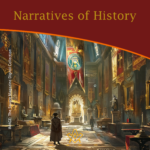 Narratives of History |
 A Very Royal Sesquicentenary |
 Unveiling the Enigma: Discover the Royal Society's Legacy and its Impact on Science. Delve into the fascinating history of the Royal Society, the prestigious UK academy shaping scientific progress since 1660. Explore its pivotal role in advancing knowledge, fostering collaboration, and unlocking the secrets of the universe. Prepare to be amazed! |
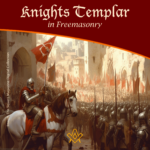 Knights Templar in Freemasonry Uncover the Mysteries of the Knights Templar in Freemasonry! Delve into the intriguing world where chivalry and symbolism intertwine. Discover the captivating rituals and ancient secrets behind the Knights Templar Masonic Orders. Explore the historical connection and delve into the enigmatic narratives that continue to fascinate enthusiasts today. Unveil the hidden truths now! |
 The Royal Arch stands as the rainbow of promise in the Ritual; it stands as the promise of the resurrection; of that which was lost and that it shall be recovered. The question arises as to whether the Master's Word was originally communicated in the Third Degree? On this point there is some diversity of opinion. Originally published in 1915, this insight into the Fourth Degree – the Holy Royal Arch – is as relevant today as it was over 100 years ago. |
 Unveiling the Mysteries of Druidism: Discover the Intriguing Connection with Freemasonry. Explore the ancient spiritual practice of Druidism and its fascinating ties to the enigmatic world of Freemasonry. Delve into the shared symbolism and rituals that have captivated minds for centuries. Unlock the secrets of these intertwined traditions today! |
 Uncover the legacy of freestone masons and their pivotal role in crafting medieval cathedrals. Discover the artistry behind their techniques, the hierarchy within their craft, and the enduring impact of their intricate carvings. A deep dive into the world of these master craftsmen awaits you! |
 Unearth the intriguing journey from Vincha Culture to Freemasonry. Discover how ancient building methods intertwine with modern Masonic philosophies. This exploration will shed light on the fascinating link between the Serbian term "shestarenye" and the symbolic significance of the compass in Freemasonry. |
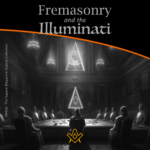 Freemasonry and the Illuminati Unravel the enigmatic world of Freemasonry and the Illuminati in our latest exposé. Dive into centuries-old mysteries, debunk conspiracy theories, and discover the truth behind these elusive societies. Are they puppet masters or mere myths? Join us as we dissect history and fact from fiction. |
 The Île des Templiers, or “Island of the Templars” lies within a leafy park in Paris. The execution site of Jacques du Molay, the last Grand Master of the Knights’ Templar bears a plaque with the epitaph ‘A cet endroit / Jacques de Molay / Dernier grand maître / de l'ordre du temple / a été brûlé le 18 Mars 1314’ (‘In this location / Jacques de Molay / Last grand master / of the order of the temple / was burned on 18 March 1314’) |
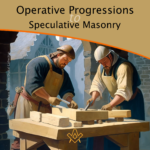 Operative Progressions to Speculative Masonry Both Operative and Speculative Masonry are an important part of the modern fraternity of Freemasonry, which combines elements of both traditions. Today, Freemasonry is a fraternity that is open to men of good character, who are interested in personal development and in making a positive contribution to their communities. |
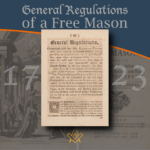 General Regulations of a Free Mason, 1723 General Regulations of a Free Mason as contained in Anderson's Constitutions of the Freemasons, published 1723. the Regulations are of great historical interest. Compiled by George Payne, the second Grand Master of the Premier Grand Lodge of England, they were printed in 1722/3, thus published just over five years after the formation of the Grand Lodge 1717. |
 The Genesis of the 1723 Book of Constitutions 2023, marks the three hundredth anniversary of the publication of the first printed Book of Constitutions of the Grand Lodge formally established in London two years previously. This is an anniversary whose significance extends beyond freemasonry. A paper by Andrew Prescott |
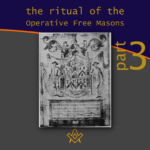 The Ritual of the Operative Free Masons - P3 Existing Operative Free Masons. The ritual I am about to refer, is that of "The Worshipful Society of Free Masons, Rough Masons, Wallers, Slaters, Paviors, Plaisterers, and Bricklayers." By Thomas Carr, M.D., P. M. Honorary Member of the Guild of Operative Free Masons |
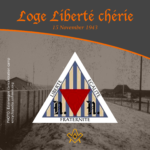 Liberté chérie was a Masonic Lodge founded in 1943 by Belgian Resistance fighters and other political prisoners at Esterwegen concentration camp. It was one of the few lodges of Freemasons founded within a Nazi concentration camp during the Second World War. |
 The Ritual of the Operative Free Masons - P2 If anyone doubts the fact that the formation of Speculative Free Masonry was due to and based upon Operative Free Masonry, it is quite easy to convince him of his error if he will only study the first Book of Constitutions. By Thomas Carr, M.D., P. M. Honorary Member of the Guild of Operative Free Masons |
 In 1881, Freemasonry rose from the ashes of a fire in the mining town of Kokomo, Summit County, Colorado. Corinthian Lodge No. 42, along with Kokomo, no longer exists but it holds the record of having been – at an elevation of 10,618 feet – the highest Masonic Lodge in the USA. |
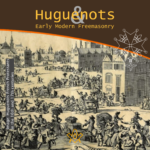 The Huguenots and Early Modern Freemasonry The Huguenots influence in the development of early modern Freemasonry at the time of the formation of the Grand Lodge in London around 1717 / 1723. |
 November is a month of reflection – perhaps due to the fact that we are getting close to the years' end – but also because Remembrance / Armistice Day (11 November) is a significant date in most countries' diaries. |
 Speculative Freemasonry, as practise by Grand Lodge of England, was officially born just over three hundred years ago, is today an international organisation, counting over six million members. It has been subjected to persecution, suppression, and abolition throughout its history. In its infancy, only a couple of decades after its official birth, it had already become a target. |
 The Ritual of the Operative Free Masons - P1 The original paper was written, first, to prove that Speculative Free Masonry was derived from Operative Free Masonry; second, to give some account of the Operative Free Masons, of their Ritual, and of their customs. By Thomas Carr, M.D., P. M. Honorary Member of the Guild of Operative Free Masons |
 American Fraternalism in the 19th and Early 20th Centuries The late 19th and early 20th centuries in the United States has been called the "Golden Age of Fraternalism." How did this come about and why was the idea of joining a fraternal organization so popular? We will explore this question and examine the regalia used by many fraternal organizations in this period. |
 Societas Draconistarum, meaning "Society of the Dragonists"– was a chivalric Order for selected nobility, founded in 1408 by Sigismund von Luxembourg, who through marriage became the King of Hungary (1387–1437) and later Holy Roman Emperor. The Order was fashioned after the military orders of the Crusades, requiring its initiates to defend the cross and fight the enemies of Christianity, in particular the Ottoman Empire. |
 The Perjured Free Mason Detected Was Samuel Prichard a perjured individual, or simply a misguided Freemason? Prichard's book "Free Masonry Dissected" published in 1730, is now used by many Masonic historians as a source of reference with regards to the introduction of the third degree into the Craft. But at the time it was published in 1730, it was not so well received by members of the Grand Lodge of England. |
 17th century and the Holy Royal Arch This article focuses on a period of transition between a point in time when we can safely and historically identify the first formation of what could be called as the ‘Royal Arch’ and the historical events that have preceded it. |
 Most Freemasons have heard the terms 'Operative' and 'Speculative' Masons, and this article helps to understand the difference: |
 Roberts' Constitutions of Freemasonry 1722 Published a year before Anderson's Constitutions, The Old Constitutions Belonging to the Ancient and Honourable SOCIETY OF Free and Accepted MASONS. Originally printed in London England; Sold by J. Roberts, in Warwick-Lane, MDCCXXII.(1722) |
 From 'Songs of religion and life', 1876 by John Stuart Blackie (1809-1895) |
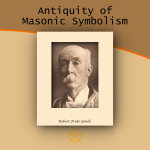 On the Antiquity of Masonic Symbolism Is the Symbolism of Masonry an inheritance derived from the old Masons who flourished before the era of the Grand Lodges (1717); or has it been borrowed from the Rosicrucians or others, after 1717? |
 Mason's Marks – from Egypt to Europe? Mason's marks have been a source of intrigue, not only to Freemasons but to historians and archaeologists. The use of simple pictograms have been employed for millennia by artisans to identify their work. But where did they originate and why? |
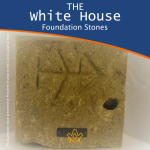 The White House Foundation Stones Further to the articles in our series on the history of the stone masons, we have a rather intriguing addition. During the 1950's renovation of the White House, President Truman retrieved more than 100 stone blocks with stonemasons marks. |
 What the Goose and Gridiron Tavern is in the ancient annals of London Freemasonry, The Green Dragon Tavern is to the memories of the Free-mason, of Boston and New England. |
 Auschwitz concentration camp: video photo article taken in 2013 |
 There are two things of importance happening this day - 27 January |
 Two approaches regarding the understanding of Freemasonry |
 Masonic Research in England c1930 An article which appeared in an American Masonic magazine, c1930 and which was reproduced in England, provoking a little controversy. |
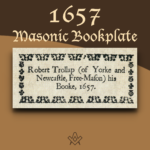 Masonic bookplates the ‘Brethren’s spiritual coats of arms and marks’ |
 The Unlawful Societies Act of 1799 Rebellious Freemasons and the 21st century |
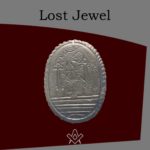 In 1912, Sarah Dowd of Dromore, Ireland, found a Masonic jewel dated 1517 - a date two hundred years before the establishment of Grand Lodge... |
 Freemasonry and Fascist Regime Interesting speech by the famous historian Prof. Aldo A. Mola, who links the fascist regime with the Masonic Associations. |
 Was famous Russian poet Alexander Pushkin a Freemason? And if so, was he a member of the lodge ‘for which all the lodges in Russia were destroyed’? |
 The Importance of Masonic Research Why is accurate - or authentic - Masonic research so important? The importance of making a daily advancement in Masonic knowledge is something that The Square is passionate about promoting. |
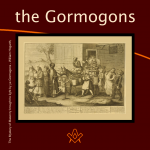 The Antient Noble Order of the Gormogons had a brief existence in the eighteenth century; they left few records or accomplishments, |
masonic knowledge
to be a better citizen of the world
share the square with two brothers

click image to open email app on mobile device
